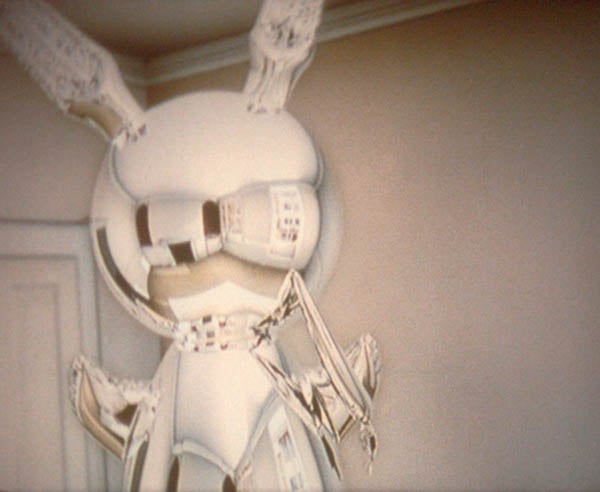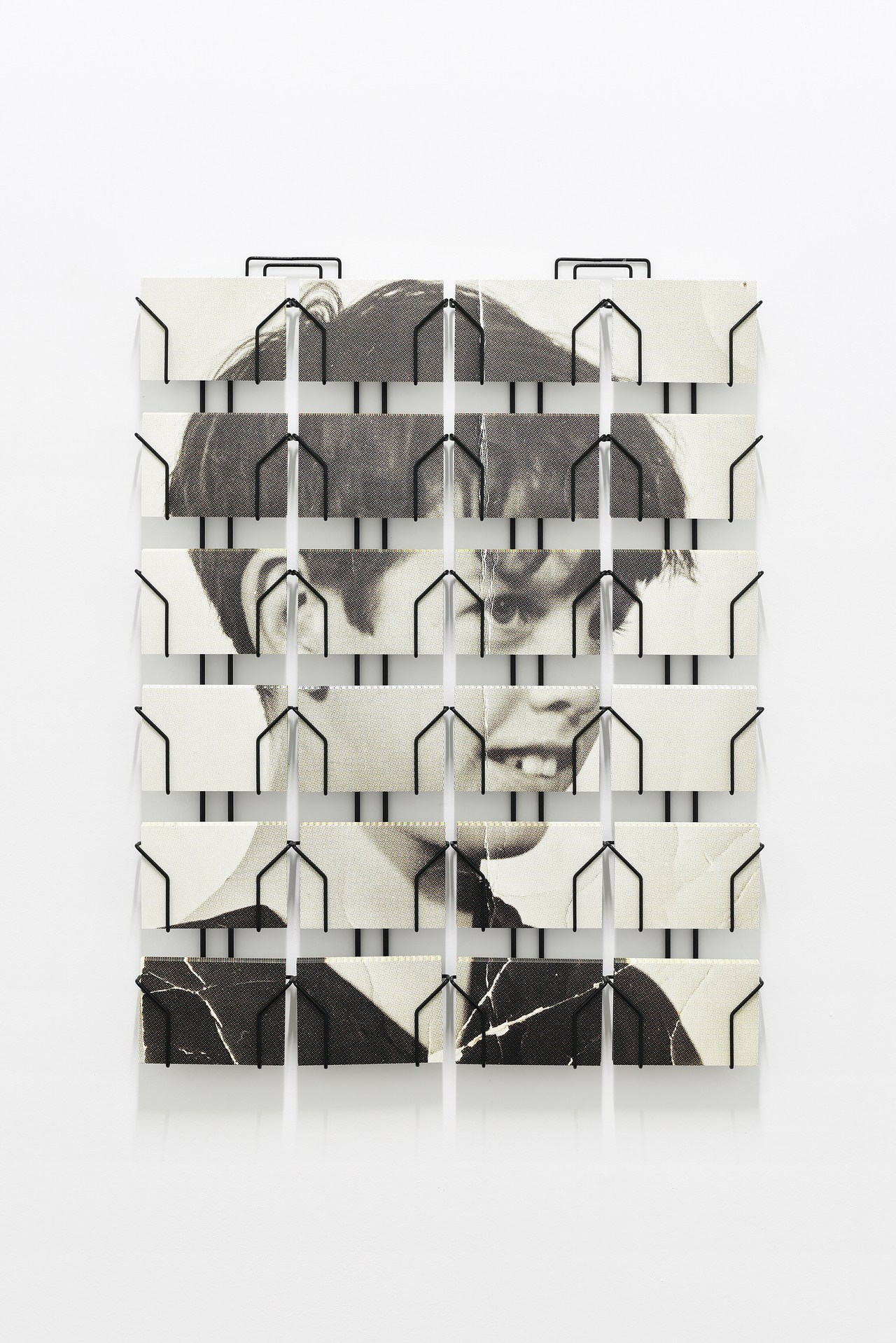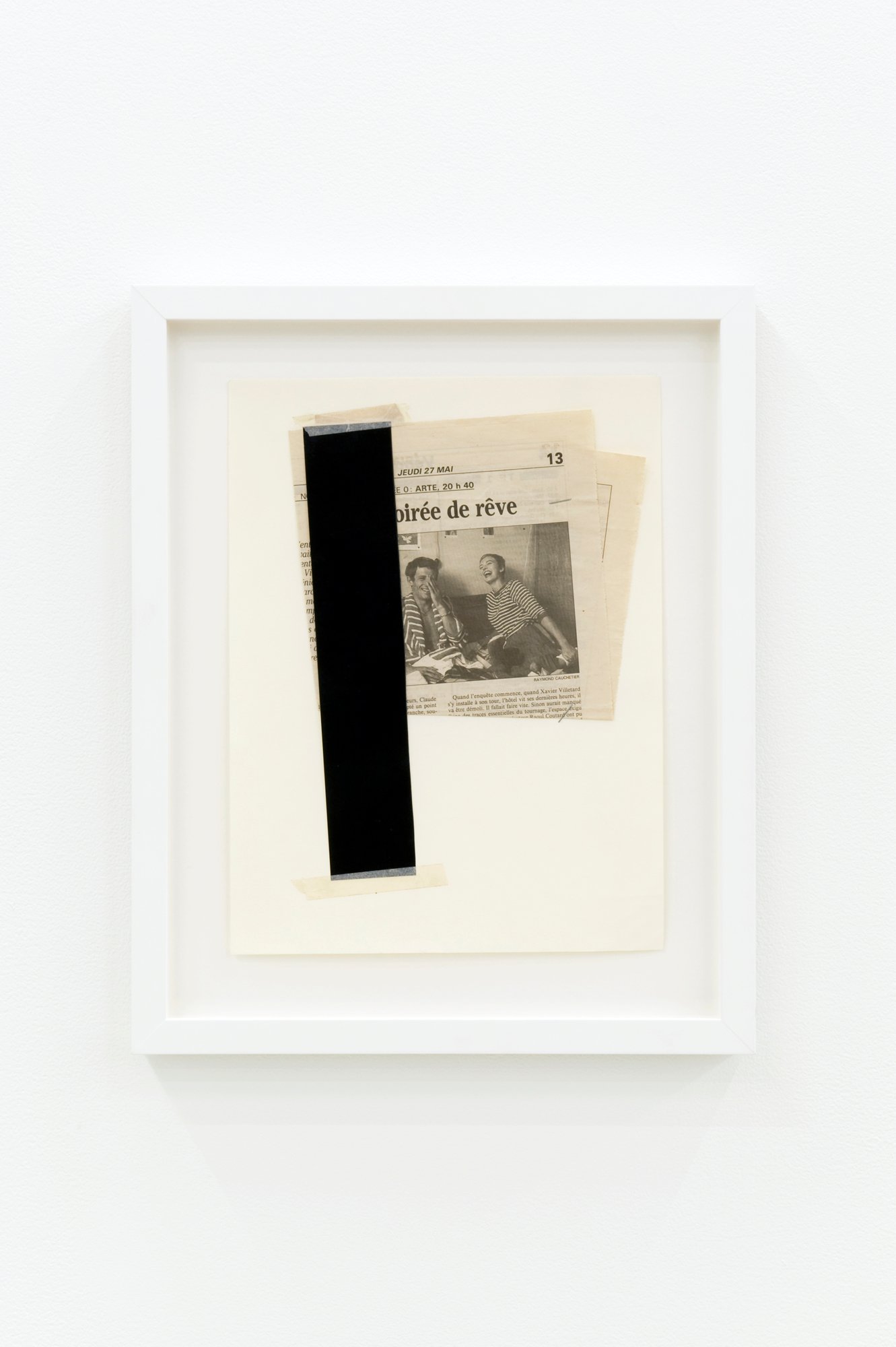
© » KADIST
Rosalind Nashashibi
Rosalind Nashashibi’s paintings incorporate motifs drawn from her day-to-day environment, often reworked with multiple variations. The development of colour palettes in her painting work could be compared to the work in her films where she delicately draws an internal visual language which provides the viewer equal space to her protagonists. Possible readings of her work are left deliberately open, encouraging thought in terms of association rather than the imposition of a narrative structure.
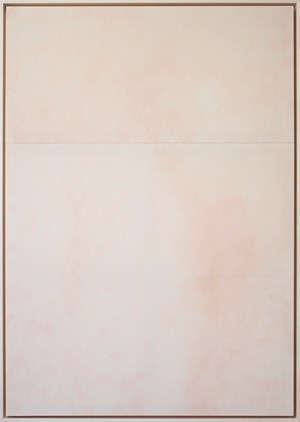
© » KADIST
Simon Fujiwara
Masks is a series of abstract paintings by Simon Fujiwara that together form a giant, fragmented portrait of German Chancellor Angela Merkel’s face. Masks (Merkel F6.1) was created in consultation with Merkel’s personal make-up artist; it features the special makeup that Merkel wears for HD cameras applied onto canvas. The image has been magnified to a near-microscopic level, rendering an ambiguous skin tone across which the makeup’s denser patches produce an abstract composition.

© » KADIST
Toby Ziegler
The Fifth Quarter might have taken its mysterious inspiration from the eponymous Stephen King story collated into the Nightmares & Dreamscapes collection. Various vanishing points and interior perspectives, like in another painting dated the same year called Continental Breakfast , create a complex matrix in which motifs, shadowy or geometric forms coexist to further confuse the map of this space. A disturbing yet alluring virtual reality composed of a medley of seemingly abstract designs is depicted through digital and painterly means.
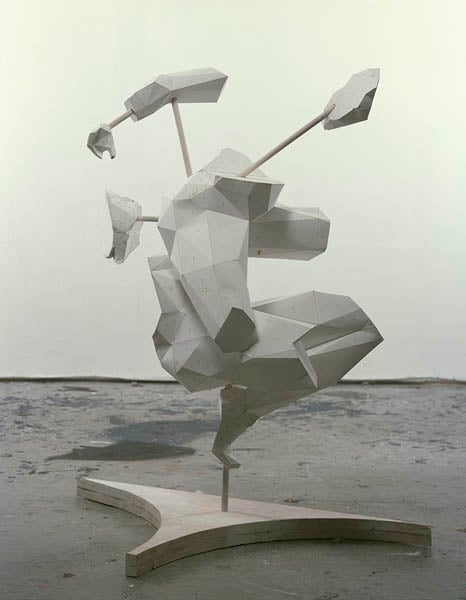
© » KADIST
Toby Ziegler
Wagon Wheel is a work with a fundamental dynamism that derives both from the rotating movement of the elements suspended on poles and the kicking of the legs of the figure. It is based on a pornographic image by Giulio Romano (ca.1499-1546). Romano had completed Raphael’s frescos in the Vatican after the latter’s death but was not paid for the work.

© » KADIST
Ryan Gander
Epiphany…learnt through hardship is composed of a bronze sculpture depicting the model of the little dancer of Degas, in the pose of a female nude photographed by Edward Weston (Nude, 1936) accompanied by a blue cube. The work refers to the positive occupations of space and the absence of form and structure, to the relationship between the visible and the invisible, to memory, and to the relationship we have to images and to our history. The work refers to childhood, biography and learning to question how meaning is made and how history is remembered and performed.
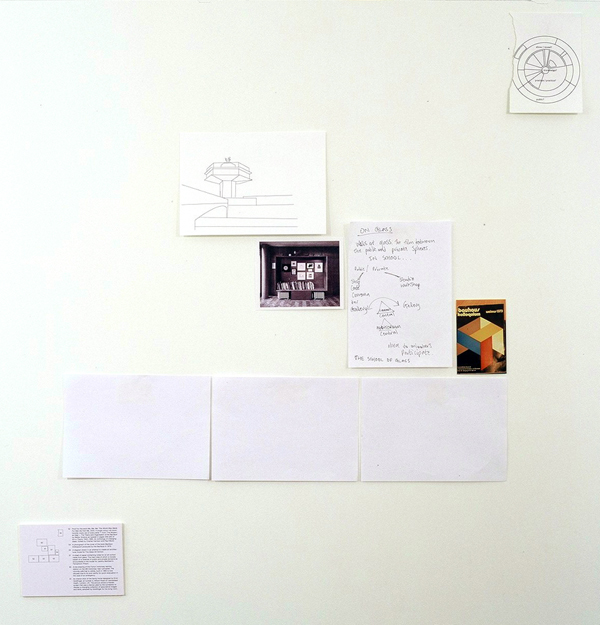
© » KADIST
Ryan Gander
You see without light is a group of photographs around the theme of Bauhaus. This includes a reference to one of Gander’s works which is the Bauhaus manifesto without dots on the letter ‘i’, as well as drawings of his ideal art school.
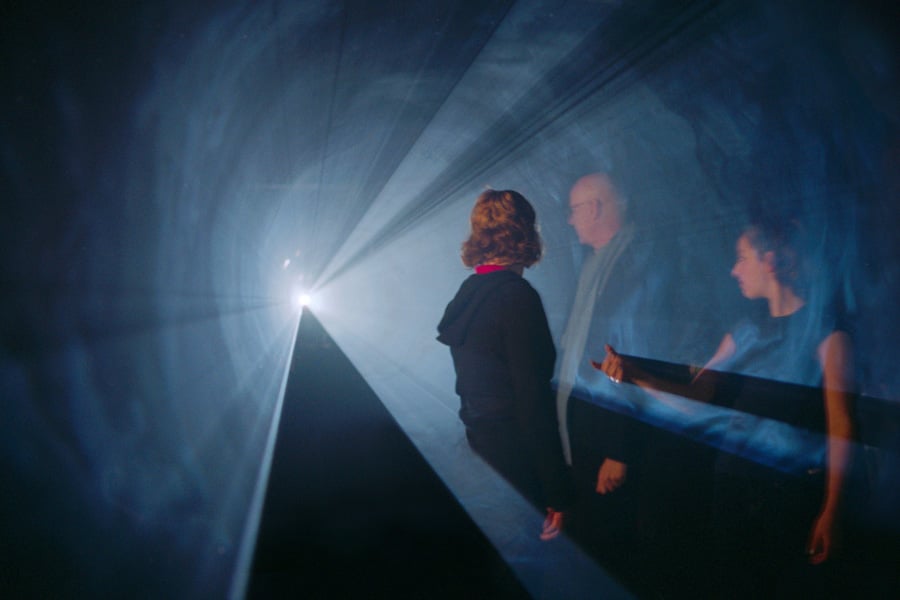
© » KADIST
Anthony McCall
The film Line Describing a Cone was made in 1973 and it was projected for the first time at Fylkingen (Stockholm) on 30 August of the same year. This piece, which was initially screened in independent film contexts, it soon began to be shown at art museums and ended up becoming one of the key works of the artistic movement that opened up the visual arts towards cinema. With a duration of 30 minutes, the film shows the creation of a white curve being projected onto an empty space.

© » KADIST
Charles Avery
Drawing & Print (Drawing & Print)
Charles Avery has been constructing a narrative in his work since 2004. Between fantasy and reality, The Islanders is a very particular universe he has created in which to gather his disparate ideas. His practice primarily involves drawing, sculptures, texts and installations which participate in the epic and dreamlike narrative whole in the course of making.

© » KADIST
Karla Black
Karla Black is a Scottish artist living in Glasgow . Her work draws from a multiplicity of artistic traditions from expressionist painting, land art performance, to formalism. Her large-scale sculptures incorporate modest everyday substances, along with very traditional art-making materials to create abstract forms.
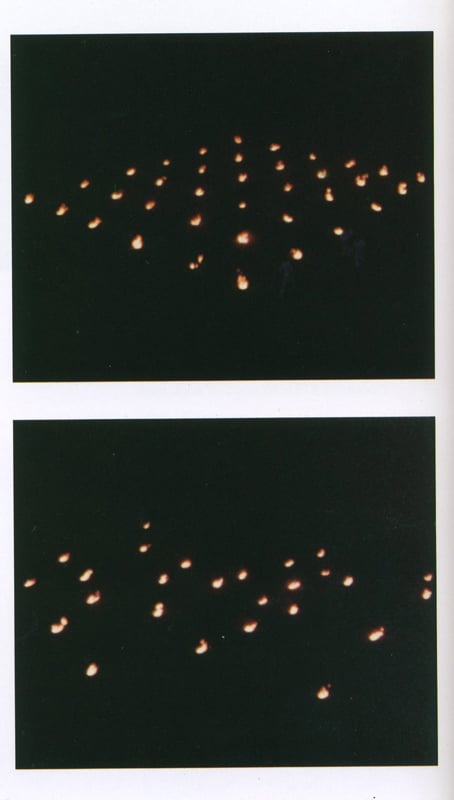
© » KADIST
Anthony McCall
Landscape for fire is a major work by Anthony McCall. The film recounts a performance where characters in white, light up fires in a very orchestrated choreography of lights in a vast flat landscape. The performance is carefully planned – the fires are lit and geometrically aligned in a precise temporal progression.

© » KADIST
Charles Avery
Drawing & Print (Drawing & Print)
Since 2005, Charles Avery has devoted his practice to the perpetual description of a fictional island. Replete with its own population and constantly shifting topography, Avery’s intricately conceived project amounts to an ever-expanding body of drawings, sculptures, installations and texts which evince the island. Exhibited incrementally these heterogeneous elements serve as terms within the unifying structure of the island – as multiple emissions of an imaginary state, and as a meditation on the central themes of philosophy and the problems of art-making.

© » KADIST
Andrew Grassie
In 2008, Grassie was invited by the Whitechapel Gallery to document the transformation of some of its spaces. The artist chose to depict the space before and after, thus creating the series titled “After the Archive Collections Room.” This group of paintings displays a space locked into time with its scaffolding and broom exposed, depicted just before an exhibition on a collection of archives.
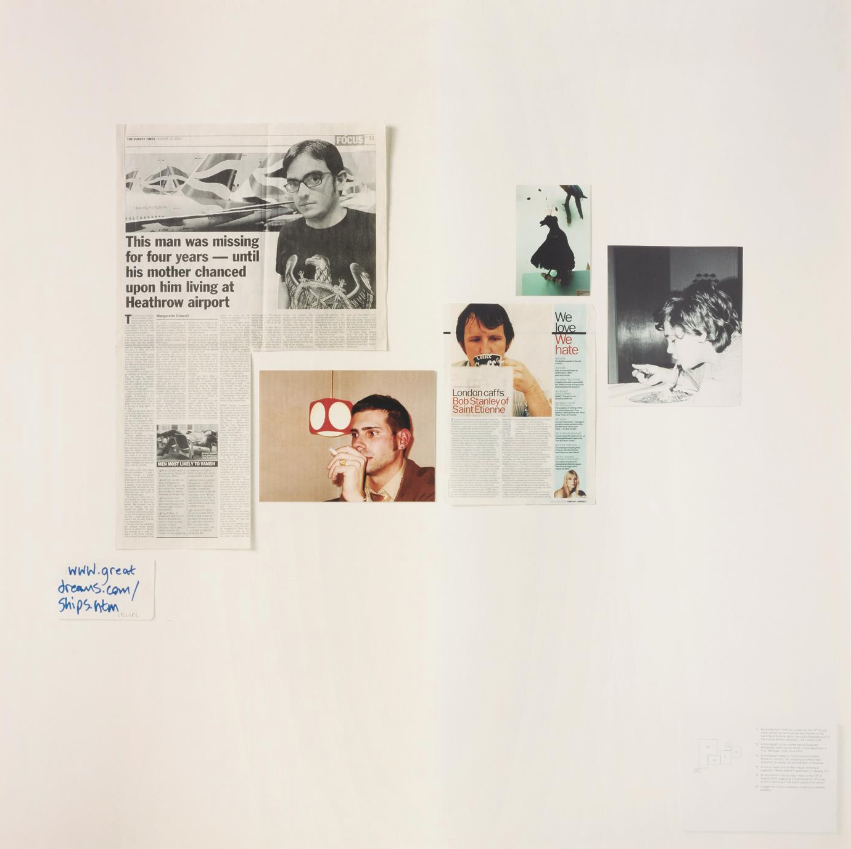
© » KADIST
Ryan Gander
Ryan Gander is a collector. He keeps all sorts of documents to create from. His studio is full of found images, personal images, documents copied from internet or cutout of newspapers.
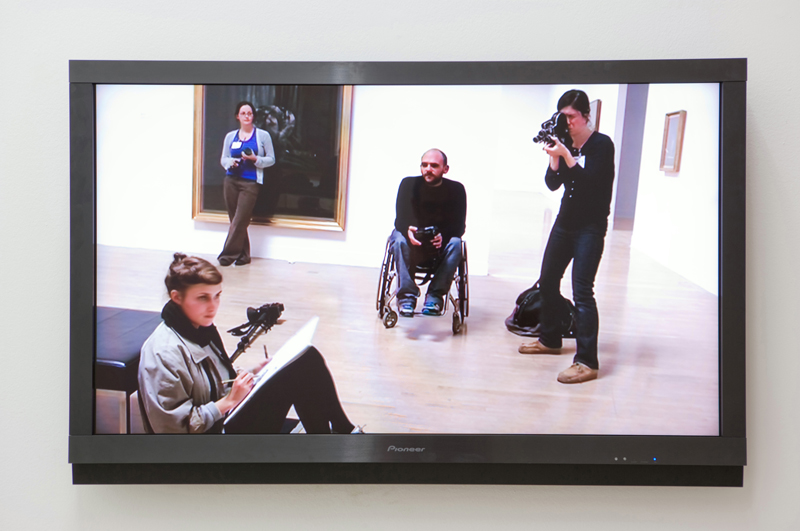
© » KADIST
Ryan Gander
The work consists of a work inside a work. The spectator is presented with a commissioned documentary on a flat-screen Tv on the subject of the production of the making of an artwork that doesn’t exist entitled The magic and the meaning (2008). The imaginary film, The magic and the meaning , is described only within the documentary, which follows parts of the making of the film, extracts from interviews with the writer and film maker Dan Fox and the artist and maker of the work Ryan Gander; as well as showing short slow-motion sections of the film that does not exist.

© » KADIST
Anthony McCall
Drawing & Print (Drawing & Print)
This score is a graphic record of the detailed choreography of one of Anthony McCall’s Landscape for Fire performances. These took place between 1972-74 in the UK at the Museum of Modern Art in Oxford, Colchester School of Art, in Reading and in North Weald as well as in Sweden at Fylkingen Society of Contemporary Music and Arts, Stockholm, and in the USA at the William Patterson University, Wayne, New Jersey. Many of these events were photographed by David Kilburn and Carolee Schneemann, only one in 1972 was filmed.

© » KADIST
Martin Boyce
In the installation Our Love is like the Flowers, the Rain, the Sea and the Hours, Martin Boyce uses common elements from public gardens – trees, benches, trashbins– in a game which describes at once a social space and an abstract dream space. The trees, unique sources of light in the exhibition space, produce their own environment. These sculptures, as if extracted from a set, are enough to suggest an atmosphere, a landscape, or a movie.
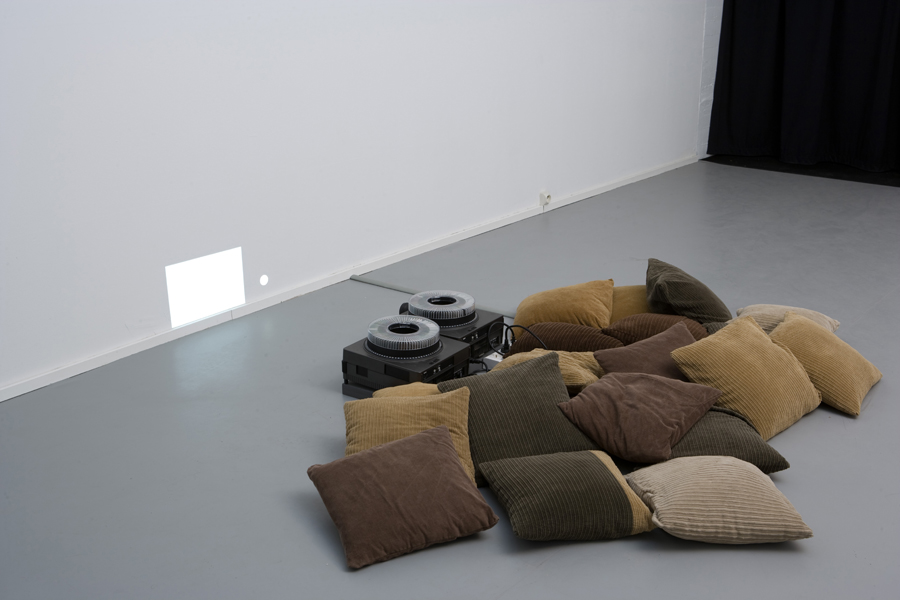
© » KADIST
Ryan Gander
This work is meditative and fragile. These abstract forms are projected slides belonging to another lecture, Travelogue , where the images have been removed. What is left is the hole of the frame of the slide that light draws upon and projects on the wall.

© » KADIST
Ian Breakwell
“BC/AD” (Before Cancer, After Diagnoses) is a video of photographs of the artist’s face dating from early childhood to the month before he died, accompanied by the last diary entries he wrote from April 2004 to July 2005 (entitled “50 Reasons for Getting Out of Bed”), from the period from when he lost his voice, thinking he had laryngitis, through the moment he was diagnosed with lung cancer and the subsequent treatment that was ultimately, ineffective. The diary entries are at once poignant, ironic, laced with gallows of humor, with his continued eye for the little incidents in life, interweaving the past with his experience of the present. The morphing of the portraits—the eyes and sight remaining leveled—is haunting, beginning with very blurry images of childhood and ending with a pin-sharp photograph of Breakwell the month before he died.

© » KADIST
Jeremy Deller
Beyond the White Walls , with a commentary written and spoken by Jeremy Deller, is often wryly amusing. The artist narrates the many projects he has completed or which are in progress beyond the gallery walls. It is beyond the gallery where Deller is at his most effective and where his art reaches out to and into people’s lives.

© » KADIST
Ryan Gander
A vehicle without light is a group of more personal photographs. This includes an image of a pirate radio in the 1960s, a story from the BBC website and the photo of Mary Aurore. Mary Aurore, is in fact a character he invented whose identity is impossible to determine but who appears in various works.
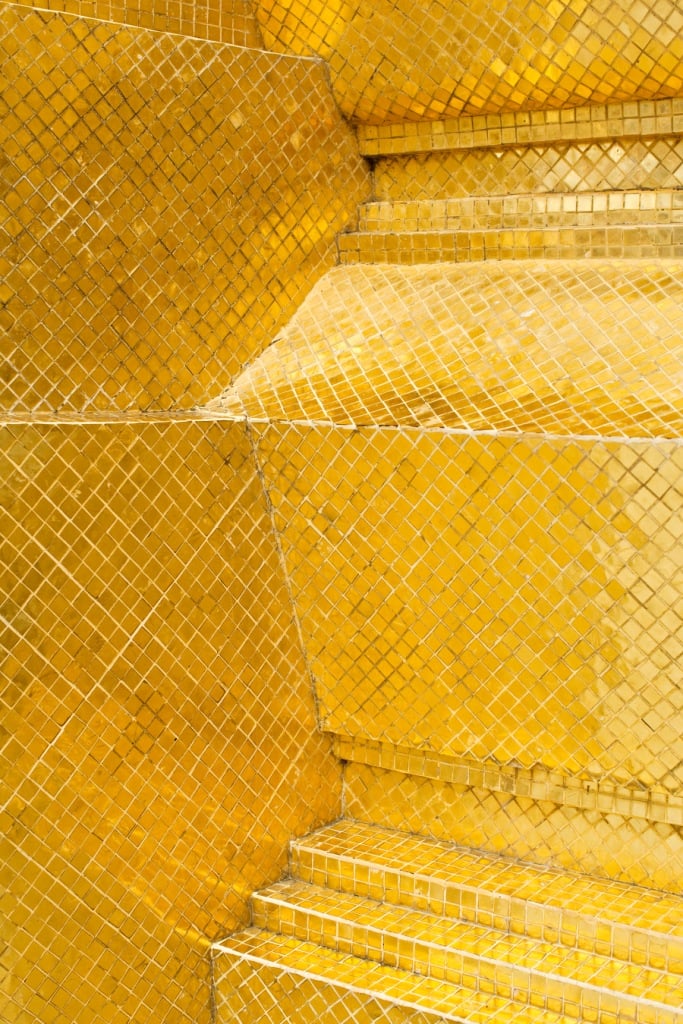
© » KADIST
Chris Wiley
Architectural details become abstracted renderings in Chris Wiley’s inkjet prints 11 and 20 (both 2012). In photographing seemingly mundane images of doorways and walls, Wiley collapses the viewer’s experience of inhabiting space by foregrounding features that we all too often miss in our built environment: the peeling white paint on a Corinthian column or the rusty studs on a blue door.

© » KADIST
Simon Starling
Invited in 2007 to the Museum Folkwang in Essen (Germany), Simon Starling questioned its history: known for its collections and particularly for its early engagement in favor of modern art (including the acquisition and exhibition of works by Cézanne, Gauguin, Van Gogh, Matisse), then destroyed during the Second World War, the museum was pillaged for its masterpieces of ‘degenerate art’ by the nazis. Starling found photographs of a hang dating back to 1929, taken by Albert Renger-Patzsch, the German New Objectivity photographer. Firstly, he researched the artworks that were presented then which for the most part had been restituted or acquired by private collectors after the war.

© » KADIST
Keith Tyson
The work of Keith Tyson is concerned with an interest in generative systems, and embraces the complexity and interconnectedness of existence. Philosophical problems such as the nature of causality, the roles of probability and design in human experience, and the limits and possibilities of human knowledge, animate much of his work. Language as a coded system, as a representation medium, but also as something that generates a whole variety of realities also plays a central role.

© » KADIST
Chris Wiley
Architectural details become abstracted renderings in Chris Wiley’s inkjet prints 11 and 20 (both 2012). In photographing seemingly mundane images of doorways and walls, Wiley collapses the viewer’s experience of inhabiting space by foregrounding features that we all too often miss in our built environment: the peeling white paint on a Corinthian column or the rusty studs on a blue door.

© » KADIST
Michael Landy
H.2. N. Y Skeleton of the Dump revolves entirely around the performance “Homage to New York” (1960), of the Swiss artist Jean Tinguely (1925-1991), during which the machine built by the artist in the gardens of the Museum of Modern Art (MOMA) had to self-destruct itself in 27 minutes, but, in the end, it had to be finished off by firemenbeing called in after it erupted in flames. Since the discovery of Jean tinguely’s retrospective at the Tate Gallery in London, in 1982, Michael Landy spent two years researching and sketching (charcoal, oil, glue, ink) from his previous research carried out at Museum Tinguely in Basel, and at the MOMA in New York.

© » KADIST
Cerith Wyn Evans
Untitled (Perfect Lovers + 1) by Cerith Wyn Evans takes as its starting point Felix Gonzales-Torres’s seminal work Untitled (Perfect Lovers) , in which two clocks were synchronized and left to run without interference, the implication being that one would stop before the other. Gonzales-Torres’ original work was a personal allusion to his own partner’s increasingly debilitating HIV-related illness, which grapples with the existential tension of coexistence in the face of death. Cerith Wyn Evans’s piece takes the same concept, and adds a third clock, moving from the intimacy of a monogamous relationship to suggest a more expansive, or possibly polyamorous alternative.
Ryan Gander
- location: Chester, United Kingdom
- year born: 1976
- gender: male
- nationality: British
Jonathan Monk
- location: Berlin, Germany
- year born: 1969
- gender: male
- nationality: British
- home town: Leicester, United Kingdom
Anthony McCall
- location: London, United Kingdom
- year born: 1946
- gender: male
- nationality: British
Ian Wallace
- year born: 1943
- gender: male
- nationality: British
- home town: Shoreham, United Kingdom
Martin Creed
- location: Wakefield, United Kingdom
- year born: 1968
- gender: male
- nationality: British
Toby Ziegler
- location: London, United Kingdom
- year born: 1972
- gender: male
- nationality: British
Cerith Wyn Evans
- location: London, United Kingdom
- year born: 1958
- gender: male
- nationality: British
- home town: Llanelli, United Kingdom
Chris Wiley
- location: New York, New York
- year born: 1981
- gender: male
- nationality: British
Charles Avery
- location: Oban, United Kingdom
- year born: 1973
- gender: male
- nationality: British
Martin Boyce
- location: Hamilton, United Kingdom
- year born: 1967
- gender: male
- nationality: British
Andrew Grassie
- location: Edinburgh, United Kingdom
- year born: 1966
- gender: male
- nationality: British
Keith Tyson
- location: Ulverston, United Kingdom
- year born: 1969
- gender: male
- nationality: British
Tacita Dean
- location: Berlin, Germany
- year born: 1965
- gender: female
- nationality: British
- home town: Canterbury, United Kingdom
Ian Breakwell
- location: Derby, United Kingdom
- year born: 1943
- gender: male
- nationality: British
Michael Landy
- location: London, United Kingdom
- year born: 1963
- gender: male
- nationality: British
Rosalind Nashashibi
- location: Croydon, United Kingdom
- year born: 1973
- gender: female
- nationality: British
Mark Leckey
- year born: 1964
- gender: male
- nationality: British
- home town: Birkenhead, United Kingdom
Karla Black
- location: Alexandria, United Kingdom
- year born: 1972
- gender: female
- nationality: British
Jeremy Deller
- location: London, United Kingdom
- year born: 1966
- gender: male
- nationality: British
Richard T. Walker
- location: San Francisco, California
- year born: 1977
- gender: male
- nationality: British
Simon Starling
- location: Copenhagen, Denmark
- year born: 1967
- gender: male
- nationality: British
- home town: Epsom, United Kingdom
Chris Ofili
- location: Manchester, United Kingdom
- year born: 1968
- gender: male
- nationality: British
Simon Fujiwara
- location: Berlin, Germany
- year born: 1982
- gender: male
- nationality: British
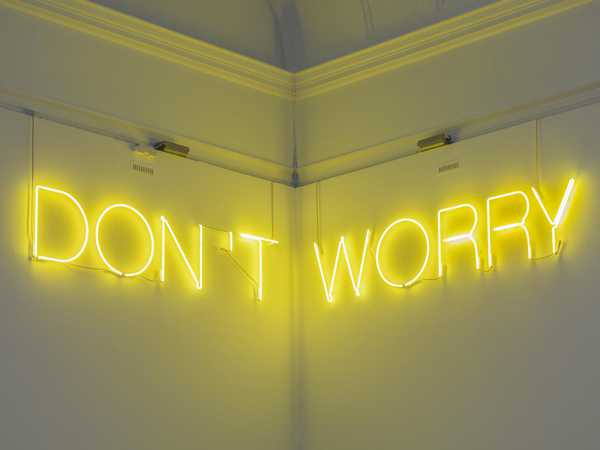
© » TATE EXHIBITIONS
about 4 months ago (01/06/2024)
Martin Creed | The Dick Institute Experience the work of one of this country’s most ingenious, audacious and surprising artists at the Dick Institute ARTIST ROOMS Martin Creed presents highlights from the British artist’s thirty-year career...
-
1970-1979
Anthony McCall
1973The film Line Describing a Cone was made in 1973 and it was projected for the first time at Fylkingen (Stockholm) on 30 August of the same year...
Anthony McCall
Drawing & Print
1974(Drawing & Print) This score is a graphic record of the detailed choreography of one of Anthony McCall’s Landscape for Fire performances...
-
1980-1989
Ian Wallace
1986Wallace says of his Heroes in the Street series, “The street is the site, metaphorically as well as in actuality, of all the forces of society and economics imploded upon the individual, who, moving within the dense forest of symbols of the modern city, can achieve the status of the heroic.” The hero in Study for my Heroes in the Street (Stan) is the photoconceptual artist Stan Douglas, who is depicted here (and also included in the Kadist Collection) as an archetypal figure restlessly drifting the streets of the modern world...
-
2000-2009
Ian Wallace
2000Untitled (Breathless) presents a folded newspaper article on Jean-Luc Godard’s À Bout de Souffle (Breathless)...
Tacita Dean
2001The photographic quality of the film Baobab is not only the result of a highly sophisticated use of black and white and light, but also of the way in which each tree is characterized as an individual, creating in the end a series of portraits...
Martin Boyce
2003In the installation Our Love is like the Flowers, the Rain, the Sea and the Hours, Martin Boyce uses common elements from public gardens – trees, benches, trashbins– in a game which describes at once a social space and an abstract dream space...
Jonathan Monk
2003Untitled (rolled up) , is an abstract portrait of Owen Monk, the artist’s father and features an aluminum ring of 56.6 cm in diameter measuring 1.77 cm in circumference, the size of his father...
Martin Creed
2003This photograph of Martin Creed himself was used as the invitation card for a fundraising auction of works on paper at Christie’s South Kensington in support of Camden Arts Centre’s first year in a refurbished building in 2005...
Mark Leckey
2004In Made In Heaven , we are face to face with a sculptural apparition, a divine visitation in the artist’s studio...
Toby Ziegler
2005The Fifth Quarter might have taken its mysterious inspiration from the eponymous Stephen King story collated into the Nightmares & Dreamscapes collection...
Toby Ziegler
2007Wagon Wheel is a work with a fundamental dynamism that derives both from the rotating movement of the elements suspended on poles and the kicking of the legs of the figure...
Simon Starling
2007Invited in 2007 to the Museum Folkwang in Essen (Germany), Simon Starling questioned its history: known for its collections and particularly for its early engagement in favor of modern art (including the acquisition and exhibition of works by Cézanne, Gauguin, Van Gogh, Matisse), then destroyed during the Second World War, the museum was pillaged for its masterpieces of ‘degenerate art’ by the nazis...
Ian Breakwell
2008“BC/AD” (Before Cancer, After Diagnoses) is a video of photographs of the artist’s face dating from early childhood to the month before he died, accompanied by the last diary entries he wrote from April 2004 to July 2005 (entitled “50 Reasons for Getting Out of Bed”), from the period from when he lost his voice, thinking he had laryngitis, through the moment he was diagnosed with lung cancer and the subsequent treatment that was ultimately, ineffective...
Cerith Wyn Evans
2008Untitled (Perfect Lovers + 1) by Cerith Wyn Evans takes as its starting point Felix Gonzales-Torres’s seminal work Untitled (Perfect Lovers) , in which two clocks were synchronized and left to run without interference, the implication being that one would stop before the other...
Andrew Grassie
2009In 2008, Grassie was invited by the Whitechapel Gallery to document the transformation of some of its spaces...
-
2010-2019
Charles Avery
Drawing & Print
2011(Drawing & Print) Charles Avery has been constructing a narrative in his work since 2004...
Ryan Gander
2012Epiphany…learnt through hardship is composed of a bronze sculpture depicting the model of the little dancer of Degas, in the pose of a female nude photographed by Edward Weston (Nude, 1936) accompanied by a blue cube...
Charles Avery
Drawing & Print
2012(Drawing & Print) Since 2005, Charles Avery has devoted his practice to the perpetual description of a fictional island...
Jeremy Deller
2012Beyond the White Walls , with a commentary written and spoken by Jeremy Deller, is often wryly amusing...
Chris Wiley
2012Architectural details become abstracted renderings in Chris Wiley’s inkjet prints 11 and 20 (both 2012)...
Chris Wiley
2012Architectural details become abstracted renderings in Chris Wiley’s inkjet prints 11 and 20 (both 2012)...
Simon Fujiwara
2016Masks is a series of abstract paintings by Simon Fujiwara that together form a giant, fragmented portrait of German Chancellor Angela Merkel’s face...
Rosalind Nashashibi
2019Rosalind Nashashibi’s paintings incorporate motifs drawn from her day-to-day environment, often reworked with multiple variations...







